Cloud Accounting Adoption in Retail SMEs in Australia: Factors
VerifiedAdded on 2023/06/03
|12
|2272
|96
Report
AI Summary
This project explores the factors influencing the adoption of cloud accounting among retail SMEs in Australia. It addresses the challenges faced by decision-makers and the contributions of vendors in encouraging cloud computing adoption. The study uses questionnaires and interviews to rank the factors affecting cloud accounting based on their significance. It defines SMEs and cloud computing, highlighting the advantages of adoption while also addressing research questions and challenges. The research adopts Transaction Cost Economics and the Technology-Organization-Environment (TOE) framework to categorize influencing factors, examining technological, organizational, and environmental considerations. The ultimate aim is to identify and rank the significant factors, such as security and legal issues, to provide businesses with informed insights for making decisions about cloud accounting. The report is based on primary research undertaken with owners/CEO's of retail SME's in the metro cities of Victoria and New South Wales.
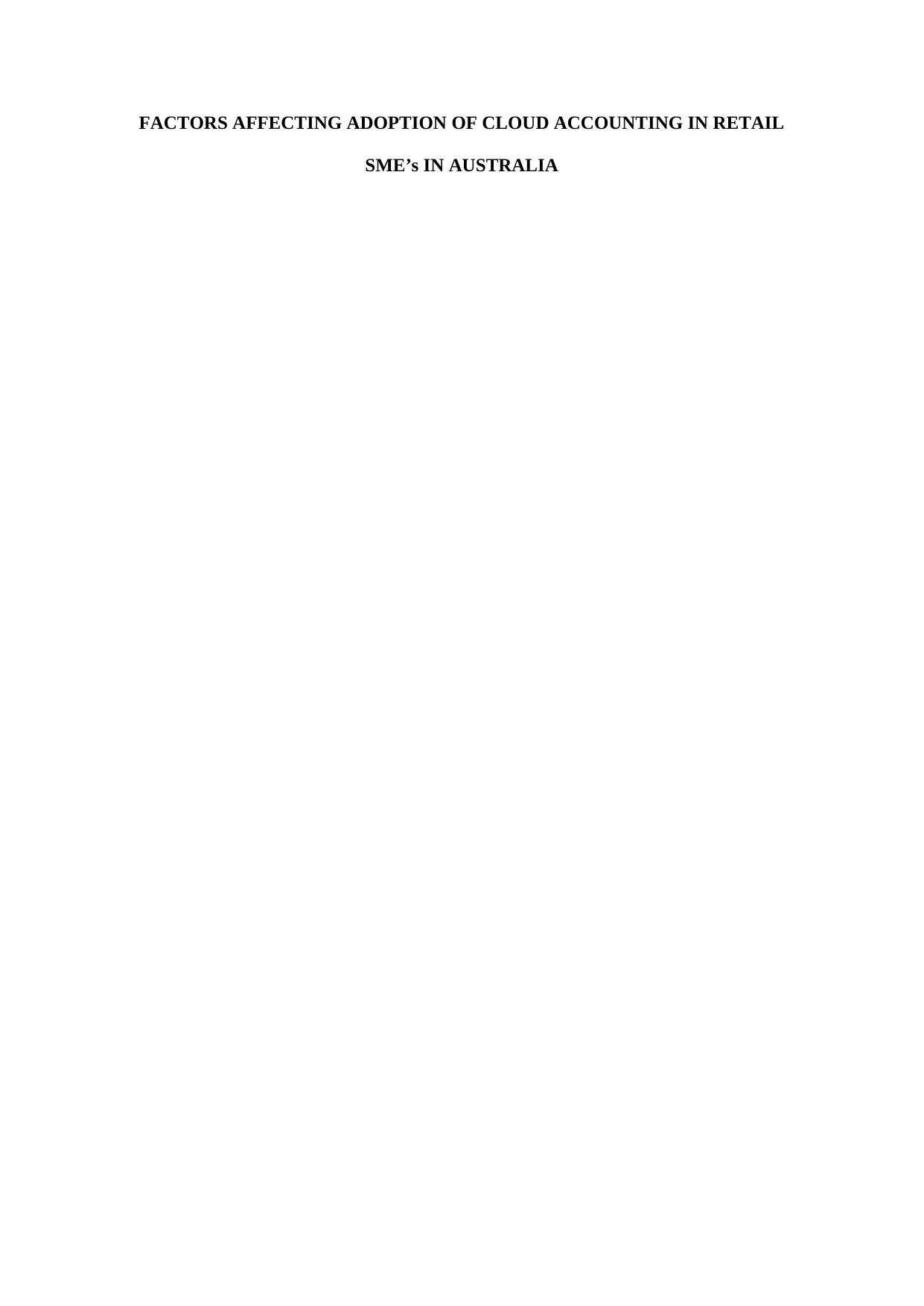
FACTORS AFFECTING ADOPTION OF CLOUD ACCOUNTING IN RETAIL
SME’s IN AUSTRALIA
SME’s IN AUSTRALIA
Paraphrase This Document
Need a fresh take? Get an instant paraphrase of this document with our AI Paraphraser
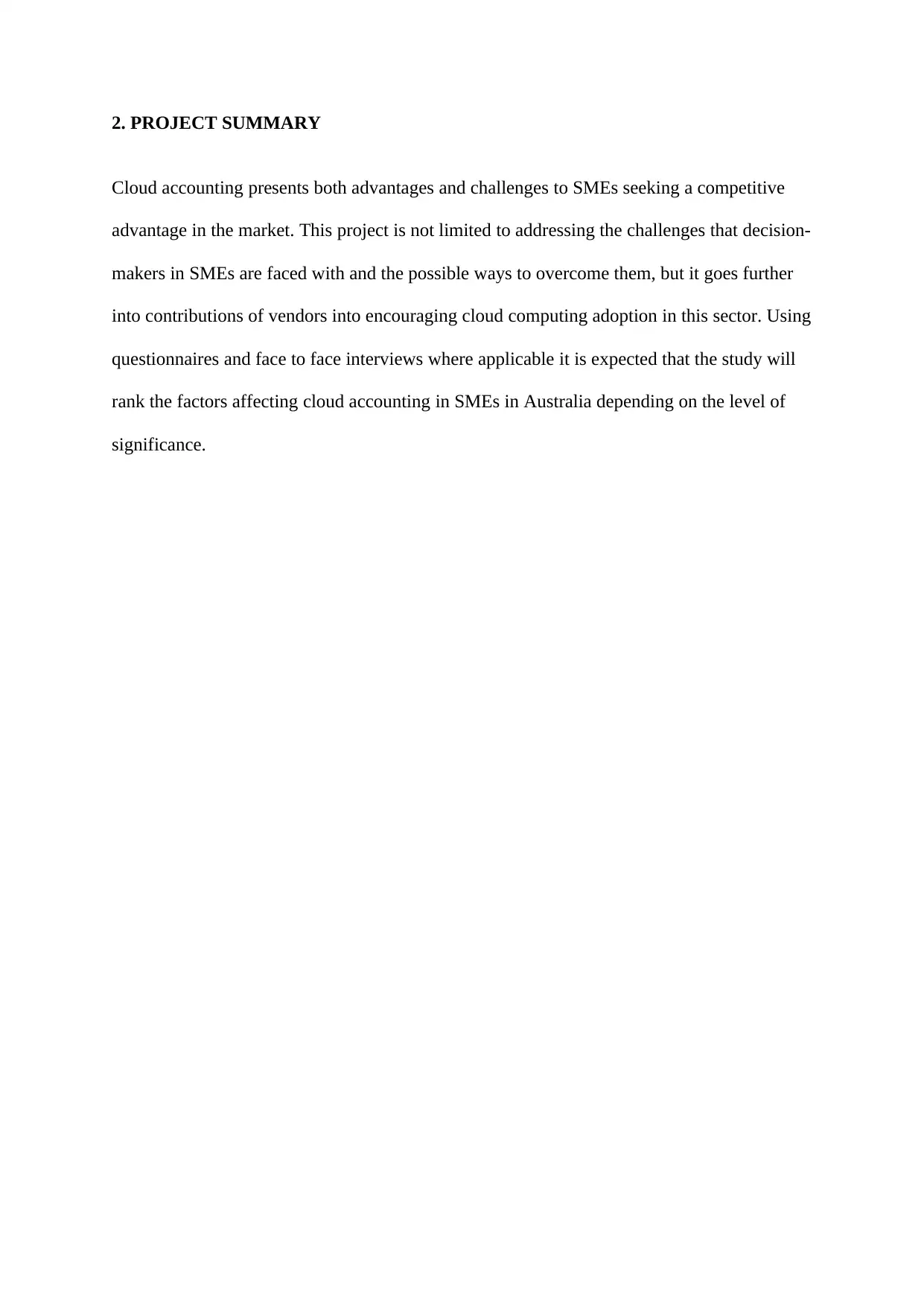
2. PROJECT SUMMARY
Cloud accounting presents both advantages and challenges to SMEs seeking a competitive
advantage in the market. This project is not limited to addressing the challenges that decision-
makers in SMEs are faced with and the possible ways to overcome them, but it goes further
into contributions of vendors into encouraging cloud computing adoption in this sector. Using
questionnaires and face to face interviews where applicable it is expected that the study will
rank the factors affecting cloud accounting in SMEs in Australia depending on the level of
significance.
Cloud accounting presents both advantages and challenges to SMEs seeking a competitive
advantage in the market. This project is not limited to addressing the challenges that decision-
makers in SMEs are faced with and the possible ways to overcome them, but it goes further
into contributions of vendors into encouraging cloud computing adoption in this sector. Using
questionnaires and face to face interviews where applicable it is expected that the study will
rank the factors affecting cloud accounting in SMEs in Australia depending on the level of
significance.
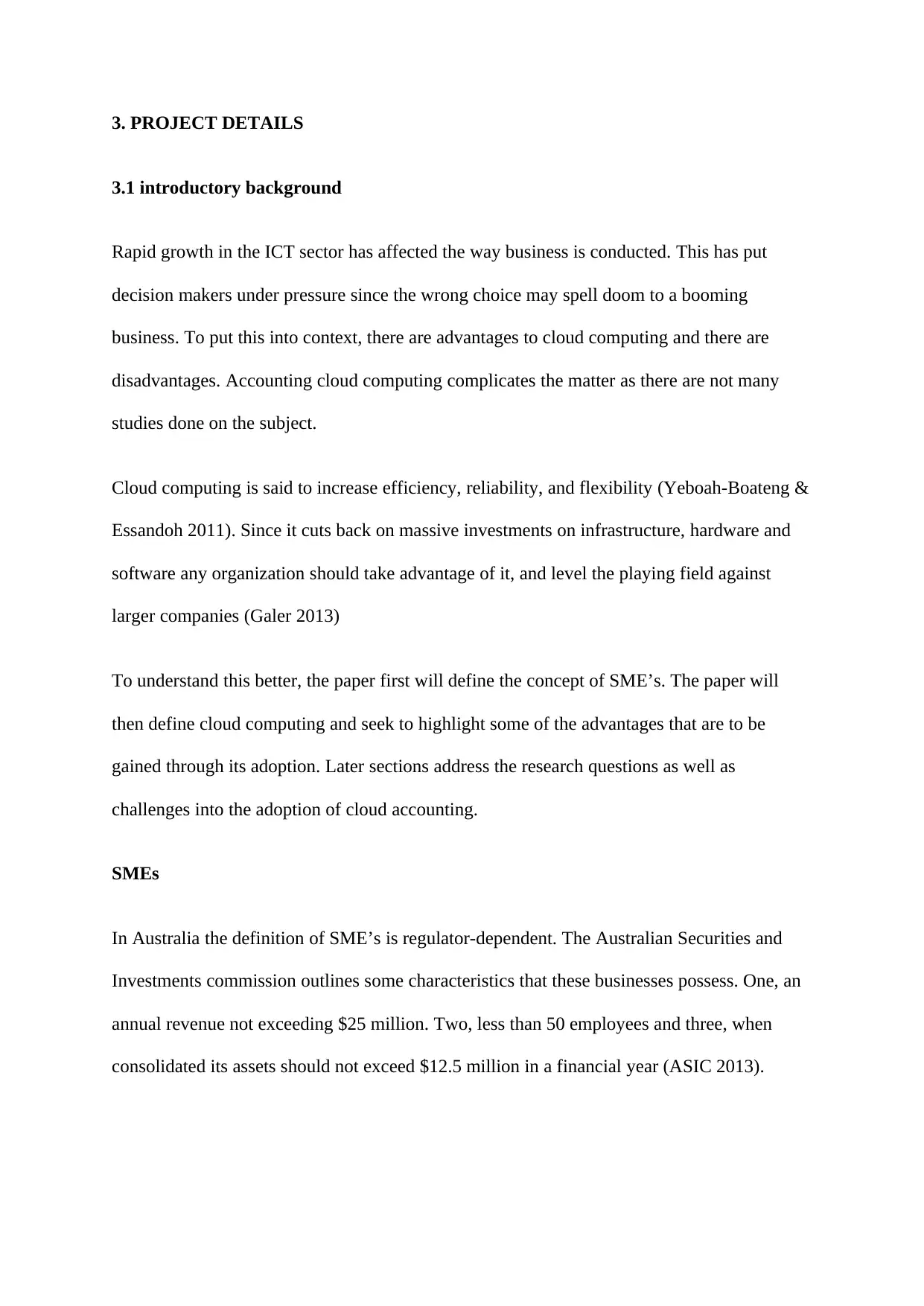
3. PROJECT DETAILS
3.1 introductory background
Rapid growth in the ICT sector has affected the way business is conducted. This has put
decision makers under pressure since the wrong choice may spell doom to a booming
business. To put this into context, there are advantages to cloud computing and there are
disadvantages. Accounting cloud computing complicates the matter as there are not many
studies done on the subject.
Cloud computing is said to increase efficiency, reliability, and flexibility (Yeboah-Boateng &
Essandoh 2011). Since it cuts back on massive investments on infrastructure, hardware and
software any organization should take advantage of it, and level the playing field against
larger companies (Galer 2013)
To understand this better, the paper first will define the concept of SME’s. The paper will
then define cloud computing and seek to highlight some of the advantages that are to be
gained through its adoption. Later sections address the research questions as well as
challenges into the adoption of cloud accounting.
SMEs
In Australia the definition of SME’s is regulator-dependent. The Australian Securities and
Investments commission outlines some characteristics that these businesses possess. One, an
annual revenue not exceeding $25 million. Two, less than 50 employees and three, when
consolidated its assets should not exceed $12.5 million in a financial year (ASIC 2013).
3.1 introductory background
Rapid growth in the ICT sector has affected the way business is conducted. This has put
decision makers under pressure since the wrong choice may spell doom to a booming
business. To put this into context, there are advantages to cloud computing and there are
disadvantages. Accounting cloud computing complicates the matter as there are not many
studies done on the subject.
Cloud computing is said to increase efficiency, reliability, and flexibility (Yeboah-Boateng &
Essandoh 2011). Since it cuts back on massive investments on infrastructure, hardware and
software any organization should take advantage of it, and level the playing field against
larger companies (Galer 2013)
To understand this better, the paper first will define the concept of SME’s. The paper will
then define cloud computing and seek to highlight some of the advantages that are to be
gained through its adoption. Later sections address the research questions as well as
challenges into the adoption of cloud accounting.
SMEs
In Australia the definition of SME’s is regulator-dependent. The Australian Securities and
Investments commission outlines some characteristics that these businesses possess. One, an
annual revenue not exceeding $25 million. Two, less than 50 employees and three, when
consolidated its assets should not exceed $12.5 million in a financial year (ASIC 2013).
You're viewing a preview
Unlock full access by subscribing today!
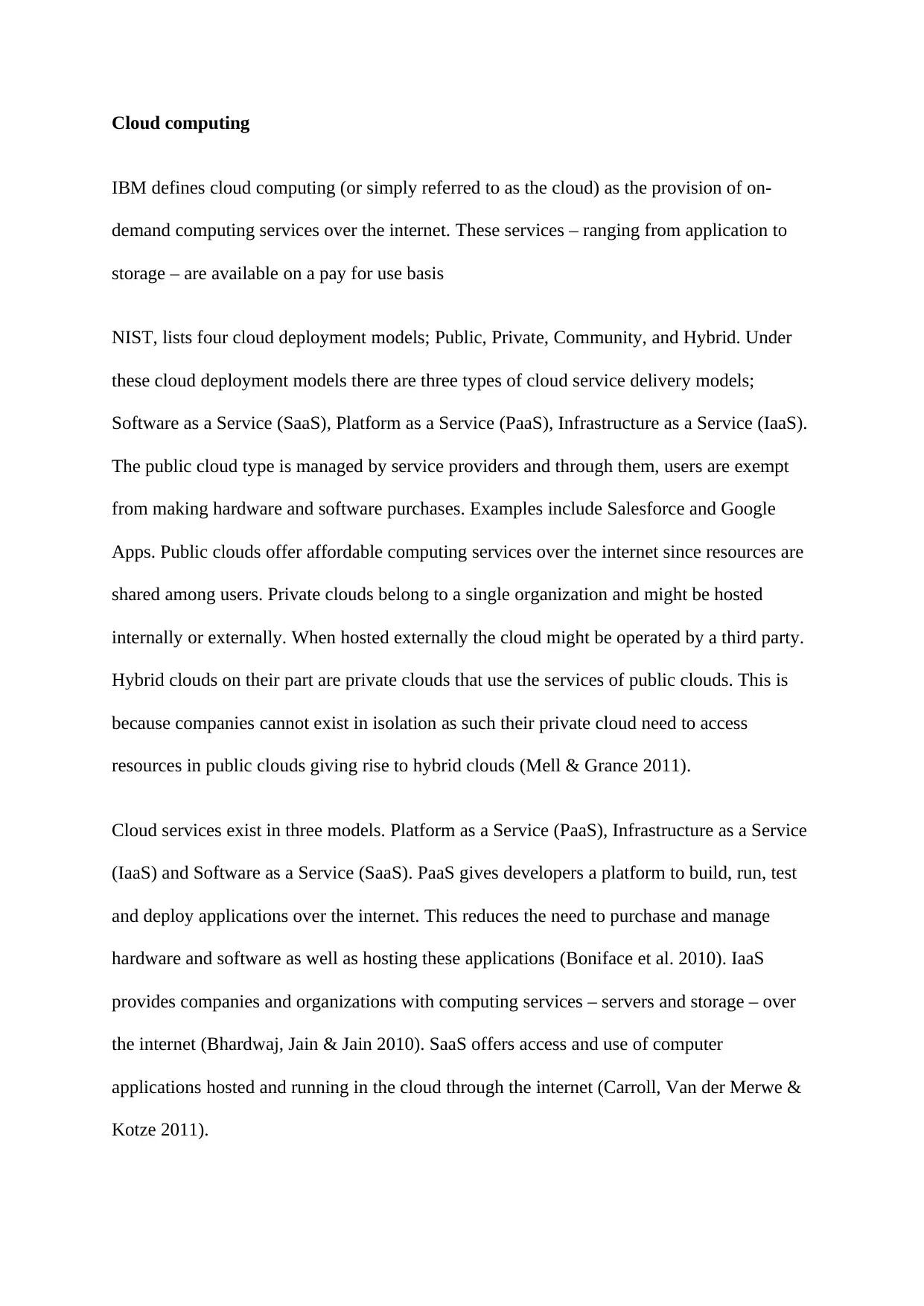
Cloud computing
IBM defines cloud computing (or simply referred to as the cloud) as the provision of on-
demand computing services over the internet. These services – ranging from application to
storage – are available on a pay for use basis
NIST, lists four cloud deployment models; Public, Private, Community, and Hybrid. Under
these cloud deployment models there are three types of cloud service delivery models;
Software as a Service (SaaS), Platform as a Service (PaaS), Infrastructure as a Service (IaaS).
The public cloud type is managed by service providers and through them, users are exempt
from making hardware and software purchases. Examples include Salesforce and Google
Apps. Public clouds offer affordable computing services over the internet since resources are
shared among users. Private clouds belong to a single organization and might be hosted
internally or externally. When hosted externally the cloud might be operated by a third party.
Hybrid clouds on their part are private clouds that use the services of public clouds. This is
because companies cannot exist in isolation as such their private cloud need to access
resources in public clouds giving rise to hybrid clouds (Mell & Grance 2011).
Cloud services exist in three models. Platform as a Service (PaaS), Infrastructure as a Service
(IaaS) and Software as a Service (SaaS). PaaS gives developers a platform to build, run, test
and deploy applications over the internet. This reduces the need to purchase and manage
hardware and software as well as hosting these applications (Boniface et al. 2010). IaaS
provides companies and organizations with computing services – servers and storage – over
the internet (Bhardwaj, Jain & Jain 2010). SaaS offers access and use of computer
applications hosted and running in the cloud through the internet (Carroll, Van der Merwe &
Kotze 2011).
IBM defines cloud computing (or simply referred to as the cloud) as the provision of on-
demand computing services over the internet. These services – ranging from application to
storage – are available on a pay for use basis
NIST, lists four cloud deployment models; Public, Private, Community, and Hybrid. Under
these cloud deployment models there are three types of cloud service delivery models;
Software as a Service (SaaS), Platform as a Service (PaaS), Infrastructure as a Service (IaaS).
The public cloud type is managed by service providers and through them, users are exempt
from making hardware and software purchases. Examples include Salesforce and Google
Apps. Public clouds offer affordable computing services over the internet since resources are
shared among users. Private clouds belong to a single organization and might be hosted
internally or externally. When hosted externally the cloud might be operated by a third party.
Hybrid clouds on their part are private clouds that use the services of public clouds. This is
because companies cannot exist in isolation as such their private cloud need to access
resources in public clouds giving rise to hybrid clouds (Mell & Grance 2011).
Cloud services exist in three models. Platform as a Service (PaaS), Infrastructure as a Service
(IaaS) and Software as a Service (SaaS). PaaS gives developers a platform to build, run, test
and deploy applications over the internet. This reduces the need to purchase and manage
hardware and software as well as hosting these applications (Boniface et al. 2010). IaaS
provides companies and organizations with computing services – servers and storage – over
the internet (Bhardwaj, Jain & Jain 2010). SaaS offers access and use of computer
applications hosted and running in the cloud through the internet (Carroll, Van der Merwe &
Kotze 2011).
Paraphrase This Document
Need a fresh take? Get an instant paraphrase of this document with our AI Paraphraser
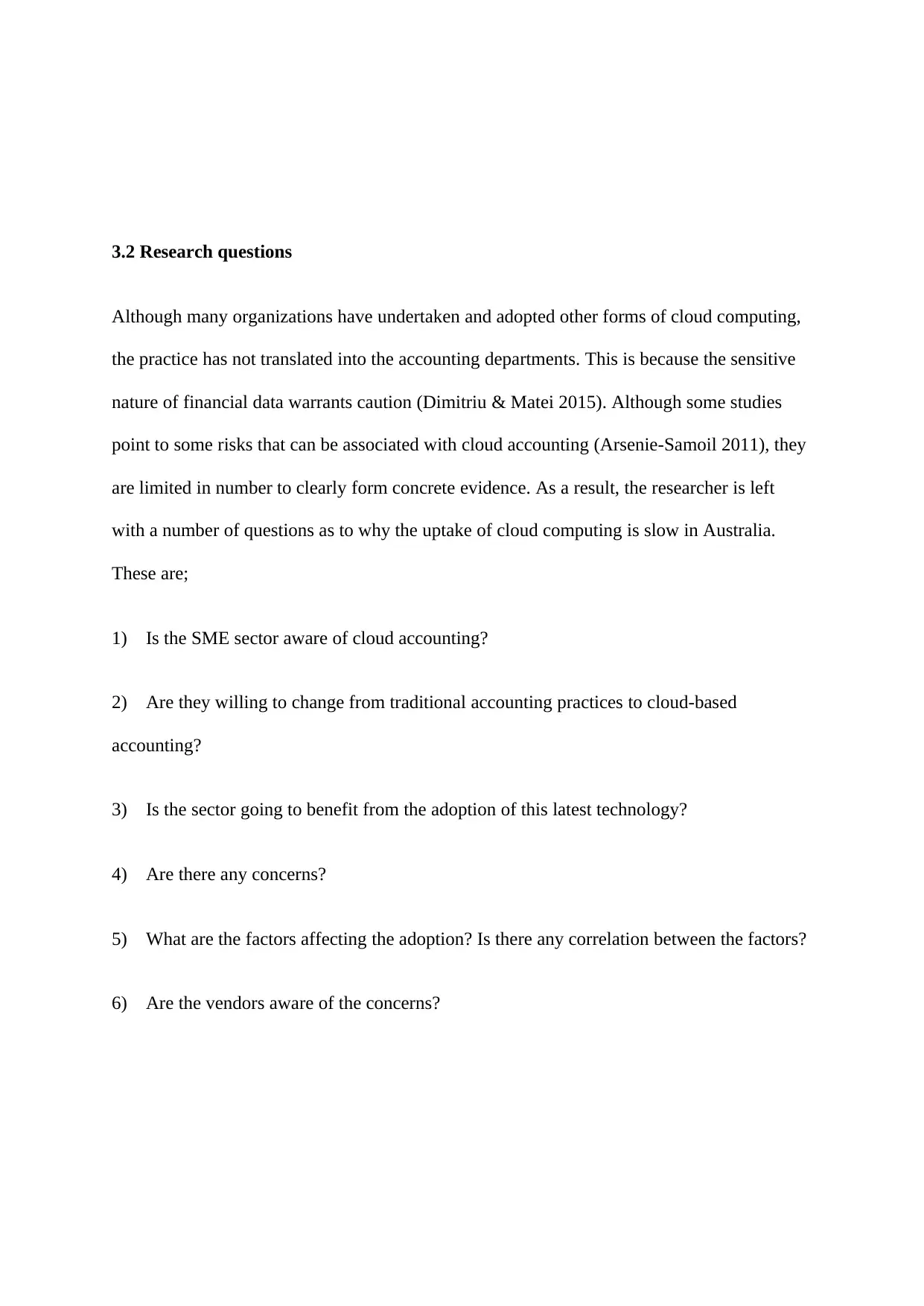
3.2 Research questions
Although many organizations have undertaken and adopted other forms of cloud computing,
the practice has not translated into the accounting departments. This is because the sensitive
nature of financial data warrants caution (Dimitriu & Matei 2015). Although some studies
point to some risks that can be associated with cloud accounting (Arsenie-Samoil 2011), they
are limited in number to clearly form concrete evidence. As a result, the researcher is left
with a number of questions as to why the uptake of cloud computing is slow in Australia.
These are;
1) Is the SME sector aware of cloud accounting?
2) Are they willing to change from traditional accounting practices to cloud-based
accounting?
3) Is the sector going to benefit from the adoption of this latest technology?
4) Are there any concerns?
5) What are the factors affecting the adoption? Is there any correlation between the factors?
6) Are the vendors aware of the concerns?
Although many organizations have undertaken and adopted other forms of cloud computing,
the practice has not translated into the accounting departments. This is because the sensitive
nature of financial data warrants caution (Dimitriu & Matei 2015). Although some studies
point to some risks that can be associated with cloud accounting (Arsenie-Samoil 2011), they
are limited in number to clearly form concrete evidence. As a result, the researcher is left
with a number of questions as to why the uptake of cloud computing is slow in Australia.
These are;
1) Is the SME sector aware of cloud accounting?
2) Are they willing to change from traditional accounting practices to cloud-based
accounting?
3) Is the sector going to benefit from the adoption of this latest technology?
4) Are there any concerns?
5) What are the factors affecting the adoption? Is there any correlation between the factors?
6) Are the vendors aware of the concerns?
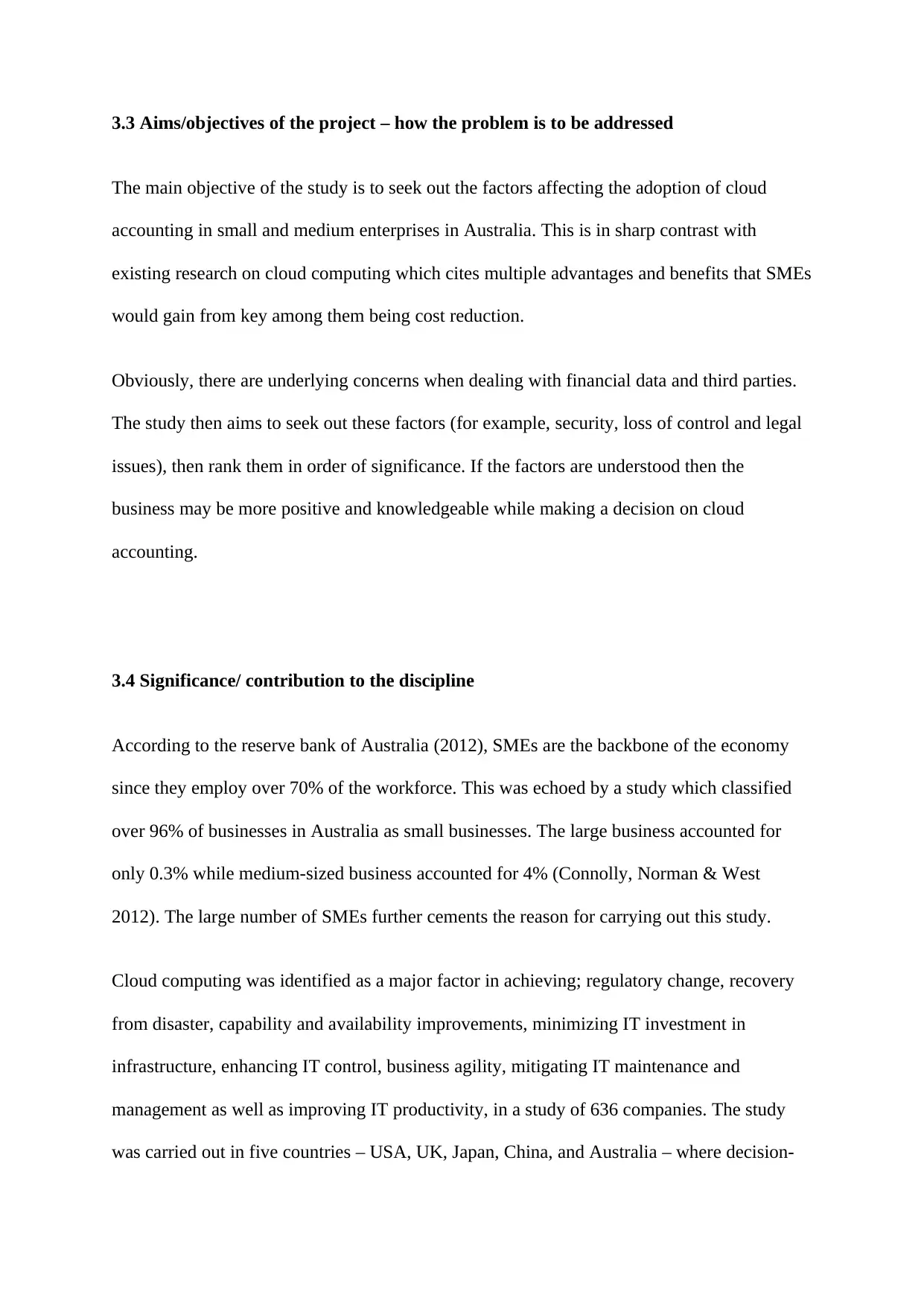
3.3 Aims/objectives of the project – how the problem is to be addressed
The main objective of the study is to seek out the factors affecting the adoption of cloud
accounting in small and medium enterprises in Australia. This is in sharp contrast with
existing research on cloud computing which cites multiple advantages and benefits that SMEs
would gain from key among them being cost reduction.
Obviously, there are underlying concerns when dealing with financial data and third parties.
The study then aims to seek out these factors (for example, security, loss of control and legal
issues), then rank them in order of significance. If the factors are understood then the
business may be more positive and knowledgeable while making a decision on cloud
accounting.
3.4 Significance/ contribution to the discipline
According to the reserve bank of Australia (2012), SMEs are the backbone of the economy
since they employ over 70% of the workforce. This was echoed by a study which classified
over 96% of businesses in Australia as small businesses. The large business accounted for
only 0.3% while medium-sized business accounted for 4% (Connolly, Norman & West
2012). The large number of SMEs further cements the reason for carrying out this study.
Cloud computing was identified as a major factor in achieving; regulatory change, recovery
from disaster, capability and availability improvements, minimizing IT investment in
infrastructure, enhancing IT control, business agility, mitigating IT maintenance and
management as well as improving IT productivity, in a study of 636 companies. The study
was carried out in five countries – USA, UK, Japan, China, and Australia – where decision-
The main objective of the study is to seek out the factors affecting the adoption of cloud
accounting in small and medium enterprises in Australia. This is in sharp contrast with
existing research on cloud computing which cites multiple advantages and benefits that SMEs
would gain from key among them being cost reduction.
Obviously, there are underlying concerns when dealing with financial data and third parties.
The study then aims to seek out these factors (for example, security, loss of control and legal
issues), then rank them in order of significance. If the factors are understood then the
business may be more positive and knowledgeable while making a decision on cloud
accounting.
3.4 Significance/ contribution to the discipline
According to the reserve bank of Australia (2012), SMEs are the backbone of the economy
since they employ over 70% of the workforce. This was echoed by a study which classified
over 96% of businesses in Australia as small businesses. The large business accounted for
only 0.3% while medium-sized business accounted for 4% (Connolly, Norman & West
2012). The large number of SMEs further cements the reason for carrying out this study.
Cloud computing was identified as a major factor in achieving; regulatory change, recovery
from disaster, capability and availability improvements, minimizing IT investment in
infrastructure, enhancing IT control, business agility, mitigating IT maintenance and
management as well as improving IT productivity, in a study of 636 companies. The study
was carried out in five countries – USA, UK, Japan, China, and Australia – where decision-
You're viewing a preview
Unlock full access by subscribing today!
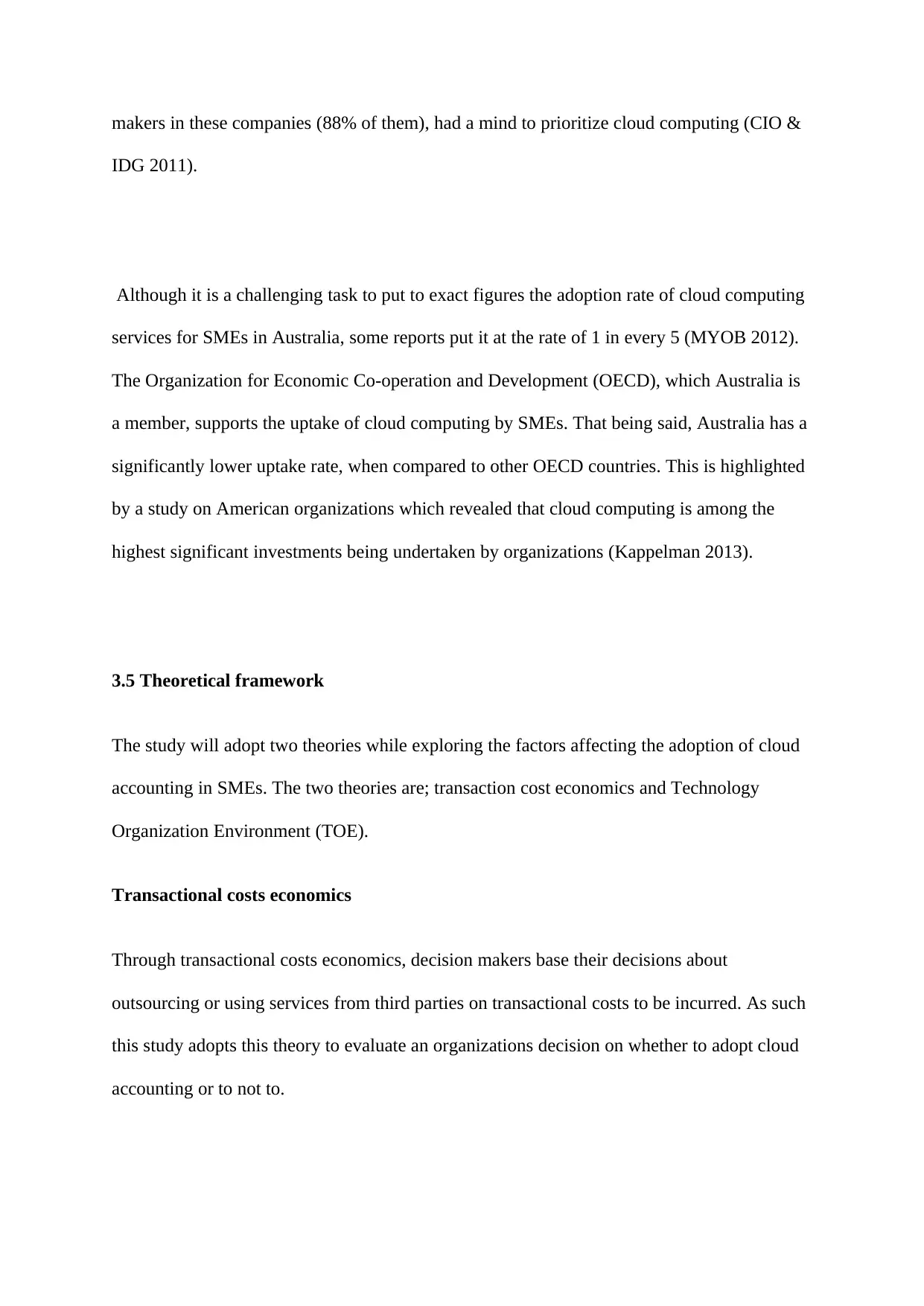
makers in these companies (88% of them), had a mind to prioritize cloud computing (CIO &
IDG 2011).
Although it is a challenging task to put to exact figures the adoption rate of cloud computing
services for SMEs in Australia, some reports put it at the rate of 1 in every 5 (MYOB 2012).
The Organization for Economic Co-operation and Development (OECD), which Australia is
a member, supports the uptake of cloud computing by SMEs. That being said, Australia has a
significantly lower uptake rate, when compared to other OECD countries. This is highlighted
by a study on American organizations which revealed that cloud computing is among the
highest significant investments being undertaken by organizations (Kappelman 2013).
3.5 Theoretical framework
The study will adopt two theories while exploring the factors affecting the adoption of cloud
accounting in SMEs. The two theories are; transaction cost economics and Technology
Organization Environment (TOE).
Transactional costs economics
Through transactional costs economics, decision makers base their decisions about
outsourcing or using services from third parties on transactional costs to be incurred. As such
this study adopts this theory to evaluate an organizations decision on whether to adopt cloud
accounting or to not to.
IDG 2011).
Although it is a challenging task to put to exact figures the adoption rate of cloud computing
services for SMEs in Australia, some reports put it at the rate of 1 in every 5 (MYOB 2012).
The Organization for Economic Co-operation and Development (OECD), which Australia is
a member, supports the uptake of cloud computing by SMEs. That being said, Australia has a
significantly lower uptake rate, when compared to other OECD countries. This is highlighted
by a study on American organizations which revealed that cloud computing is among the
highest significant investments being undertaken by organizations (Kappelman 2013).
3.5 Theoretical framework
The study will adopt two theories while exploring the factors affecting the adoption of cloud
accounting in SMEs. The two theories are; transaction cost economics and Technology
Organization Environment (TOE).
Transactional costs economics
Through transactional costs economics, decision makers base their decisions about
outsourcing or using services from third parties on transactional costs to be incurred. As such
this study adopts this theory to evaluate an organizations decision on whether to adopt cloud
accounting or to not to.
Paraphrase This Document
Need a fresh take? Get an instant paraphrase of this document with our AI Paraphraser
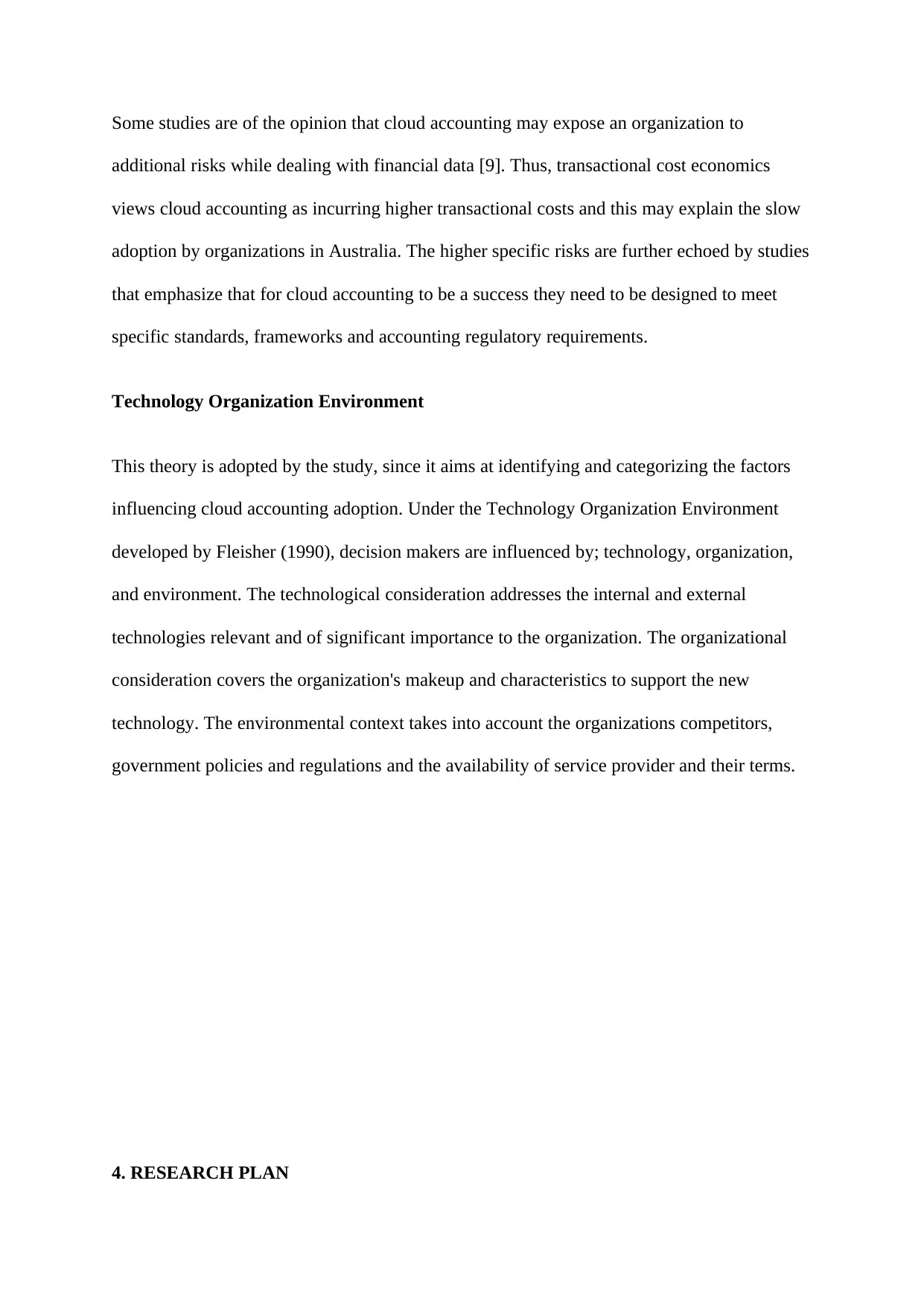
Some studies are of the opinion that cloud accounting may expose an organization to
additional risks while dealing with financial data [9]. Thus, transactional cost economics
views cloud accounting as incurring higher transactional costs and this may explain the slow
adoption by organizations in Australia. The higher specific risks are further echoed by studies
that emphasize that for cloud accounting to be a success they need to be designed to meet
specific standards, frameworks and accounting regulatory requirements.
Technology Organization Environment
This theory is adopted by the study, since it aims at identifying and categorizing the factors
influencing cloud accounting adoption. Under the Technology Organization Environment
developed by Fleisher (1990), decision makers are influenced by; technology, organization,
and environment. The technological consideration addresses the internal and external
technologies relevant and of significant importance to the organization. The organizational
consideration covers the organization's makeup and characteristics to support the new
technology. The environmental context takes into account the organizations competitors,
government policies and regulations and the availability of service provider and their terms.
4. RESEARCH PLAN
additional risks while dealing with financial data [9]. Thus, transactional cost economics
views cloud accounting as incurring higher transactional costs and this may explain the slow
adoption by organizations in Australia. The higher specific risks are further echoed by studies
that emphasize that for cloud accounting to be a success they need to be designed to meet
specific standards, frameworks and accounting regulatory requirements.
Technology Organization Environment
This theory is adopted by the study, since it aims at identifying and categorizing the factors
influencing cloud accounting adoption. Under the Technology Organization Environment
developed by Fleisher (1990), decision makers are influenced by; technology, organization,
and environment. The technological consideration addresses the internal and external
technologies relevant and of significant importance to the organization. The organizational
consideration covers the organization's makeup and characteristics to support the new
technology. The environmental context takes into account the organizations competitors,
government policies and regulations and the availability of service provider and their terms.
4. RESEARCH PLAN
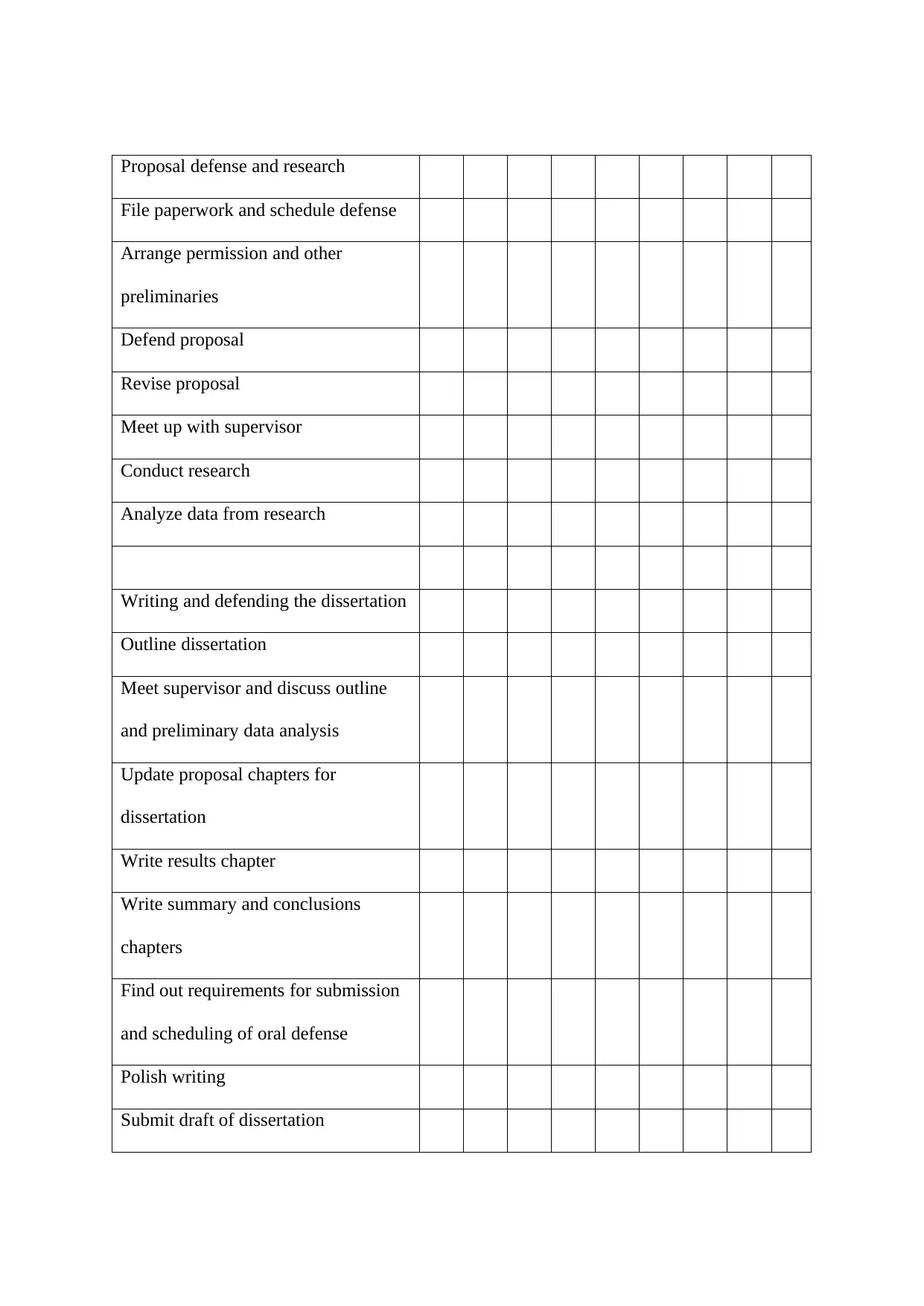
Proposal defense and research
File paperwork and schedule defense
Arrange permission and other
preliminaries
Defend proposal
Revise proposal
Meet up with supervisor
Conduct research
Analyze data from research
Writing and defending the dissertation
Outline dissertation
Meet supervisor and discuss outline
and preliminary data analysis
Update proposal chapters for
dissertation
Write results chapter
Write summary and conclusions
chapters
Find out requirements for submission
and scheduling of oral defense
Polish writing
Submit draft of dissertation
File paperwork and schedule defense
Arrange permission and other
preliminaries
Defend proposal
Revise proposal
Meet up with supervisor
Conduct research
Analyze data from research
Writing and defending the dissertation
Outline dissertation
Meet supervisor and discuss outline
and preliminary data analysis
Update proposal chapters for
dissertation
Write results chapter
Write summary and conclusions
chapters
Find out requirements for submission
and scheduling of oral defense
Polish writing
Submit draft of dissertation
You're viewing a preview
Unlock full access by subscribing today!
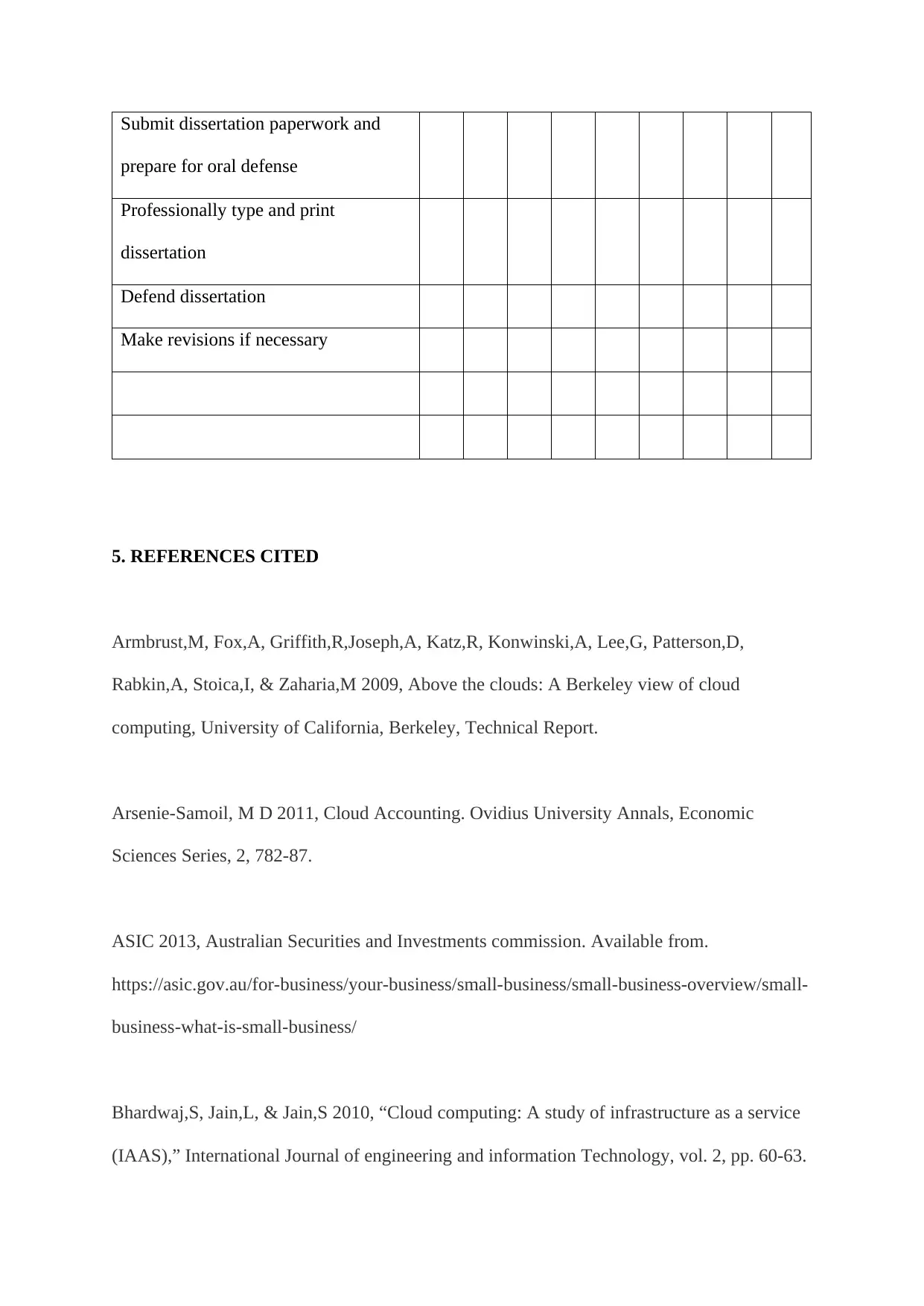
Submit dissertation paperwork and
prepare for oral defense
Professionally type and print
dissertation
Defend dissertation
Make revisions if necessary
5. REFERENCES CITED
Armbrust,M, Fox,A, Griffith,R,Joseph,A, Katz,R, Konwinski,A, Lee,G, Patterson,D,
Rabkin,A, Stoica,I, & Zaharia,M 2009, Above the clouds: A Berkeley view of cloud
computing, University of California, Berkeley, Technical Report.
Arsenie-Samoil, M D 2011, Cloud Accounting. Ovidius University Annals, Economic
Sciences Series, 2, 782-87.
ASIC 2013, Australian Securities and Investments commission. Available from.
https://asic.gov.au/for-business/your-business/small-business/small-business-overview/small-
business-what-is-small-business/
Bhardwaj,S, Jain,L, & Jain,S 2010, “Cloud computing: A study of infrastructure as a service
(IAAS),” International Journal of engineering and information Technology, vol. 2, pp. 60-63.
prepare for oral defense
Professionally type and print
dissertation
Defend dissertation
Make revisions if necessary
5. REFERENCES CITED
Armbrust,M, Fox,A, Griffith,R,Joseph,A, Katz,R, Konwinski,A, Lee,G, Patterson,D,
Rabkin,A, Stoica,I, & Zaharia,M 2009, Above the clouds: A Berkeley view of cloud
computing, University of California, Berkeley, Technical Report.
Arsenie-Samoil, M D 2011, Cloud Accounting. Ovidius University Annals, Economic
Sciences Series, 2, 782-87.
ASIC 2013, Australian Securities and Investments commission. Available from.
https://asic.gov.au/for-business/your-business/small-business/small-business-overview/small-
business-what-is-small-business/
Bhardwaj,S, Jain,L, & Jain,S 2010, “Cloud computing: A study of infrastructure as a service
(IAAS),” International Journal of engineering and information Technology, vol. 2, pp. 60-63.
Paraphrase This Document
Need a fresh take? Get an instant paraphrase of this document with our AI Paraphraser
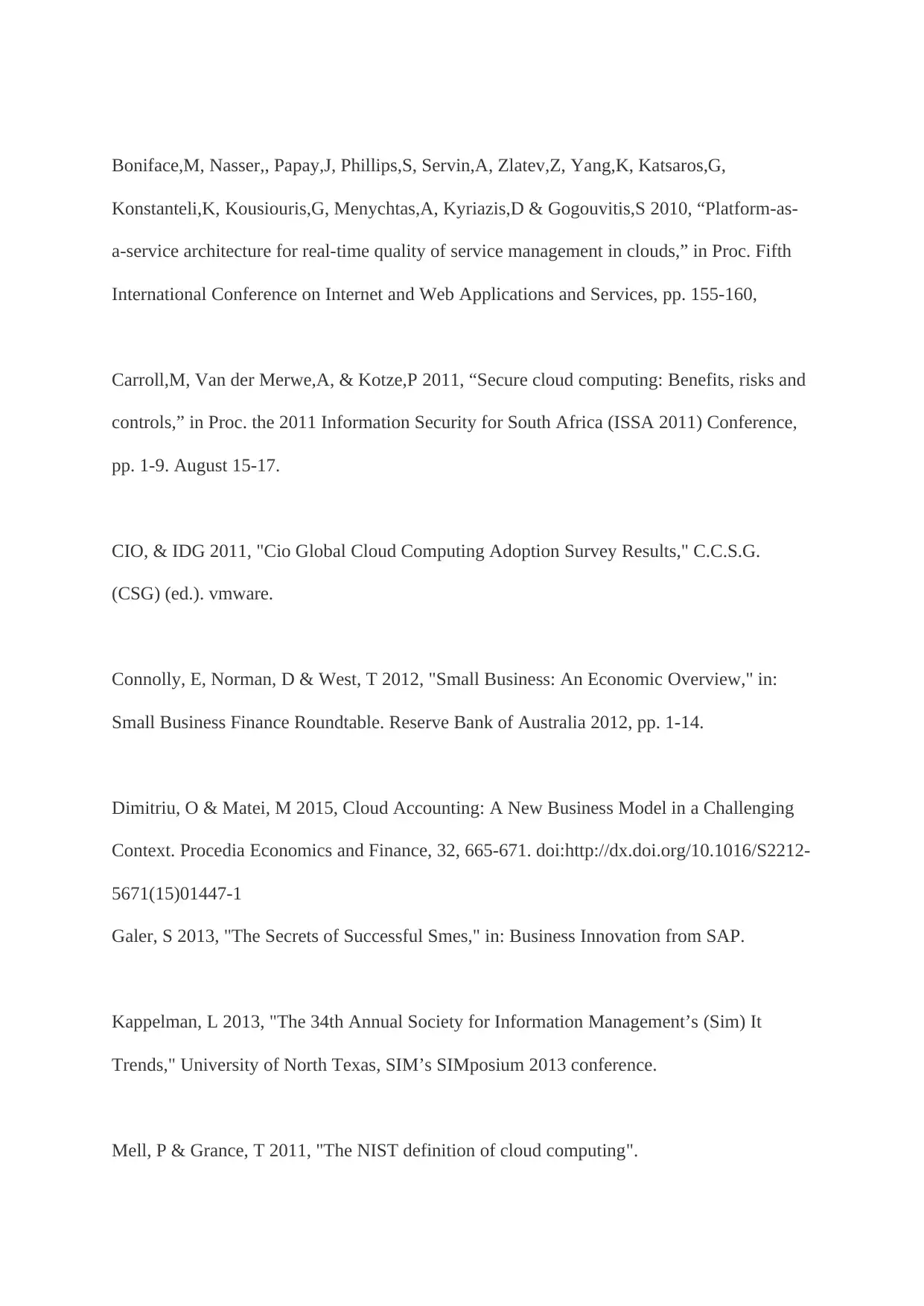
Boniface,M, Nasser,, Papay,J, Phillips,S, Servin,A, Zlatev,Z, Yang,K, Katsaros,G,
Konstanteli,K, Kousiouris,G, Menychtas,A, Kyriazis,D & Gogouvitis,S 2010, “Platform-as-
a-service architecture for real-time quality of service management in clouds,” in Proc. Fifth
International Conference on Internet and Web Applications and Services, pp. 155-160,
Carroll,M, Van der Merwe,A, & Kotze,P 2011, “Secure cloud computing: Benefits, risks and
controls,” in Proc. the 2011 Information Security for South Africa (ISSA 2011) Conference,
pp. 1-9. August 15-17.
CIO, & IDG 2011, "Cio Global Cloud Computing Adoption Survey Results," C.C.S.G.
(CSG) (ed.). vmware.
Connolly, E, Norman, D & West, T 2012, "Small Business: An Economic Overview," in:
Small Business Finance Roundtable. Reserve Bank of Australia 2012, pp. 1-14.
Dimitriu, O & Matei, M 2015, Cloud Accounting: A New Business Model in a Challenging
Context. Procedia Economics and Finance, 32, 665-671. doi:http://dx.doi.org/10.1016/S2212-
5671(15)01447-1
Galer, S 2013, "The Secrets of Successful Smes," in: Business Innovation from SAP.
Kappelman, L 2013, "The 34th Annual Society for Information Management’s (Sim) It
Trends," University of North Texas, SIM’s SIMposium 2013 conference.
Mell, P & Grance, T 2011, "The NIST definition of cloud computing".
Konstanteli,K, Kousiouris,G, Menychtas,A, Kyriazis,D & Gogouvitis,S 2010, “Platform-as-
a-service architecture for real-time quality of service management in clouds,” in Proc. Fifth
International Conference on Internet and Web Applications and Services, pp. 155-160,
Carroll,M, Van der Merwe,A, & Kotze,P 2011, “Secure cloud computing: Benefits, risks and
controls,” in Proc. the 2011 Information Security for South Africa (ISSA 2011) Conference,
pp. 1-9. August 15-17.
CIO, & IDG 2011, "Cio Global Cloud Computing Adoption Survey Results," C.C.S.G.
(CSG) (ed.). vmware.
Connolly, E, Norman, D & West, T 2012, "Small Business: An Economic Overview," in:
Small Business Finance Roundtable. Reserve Bank of Australia 2012, pp. 1-14.
Dimitriu, O & Matei, M 2015, Cloud Accounting: A New Business Model in a Challenging
Context. Procedia Economics and Finance, 32, 665-671. doi:http://dx.doi.org/10.1016/S2212-
5671(15)01447-1
Galer, S 2013, "The Secrets of Successful Smes," in: Business Innovation from SAP.
Kappelman, L 2013, "The 34th Annual Society for Information Management’s (Sim) It
Trends," University of North Texas, SIM’s SIMposium 2013 conference.
Mell, P & Grance, T 2011, "The NIST definition of cloud computing".
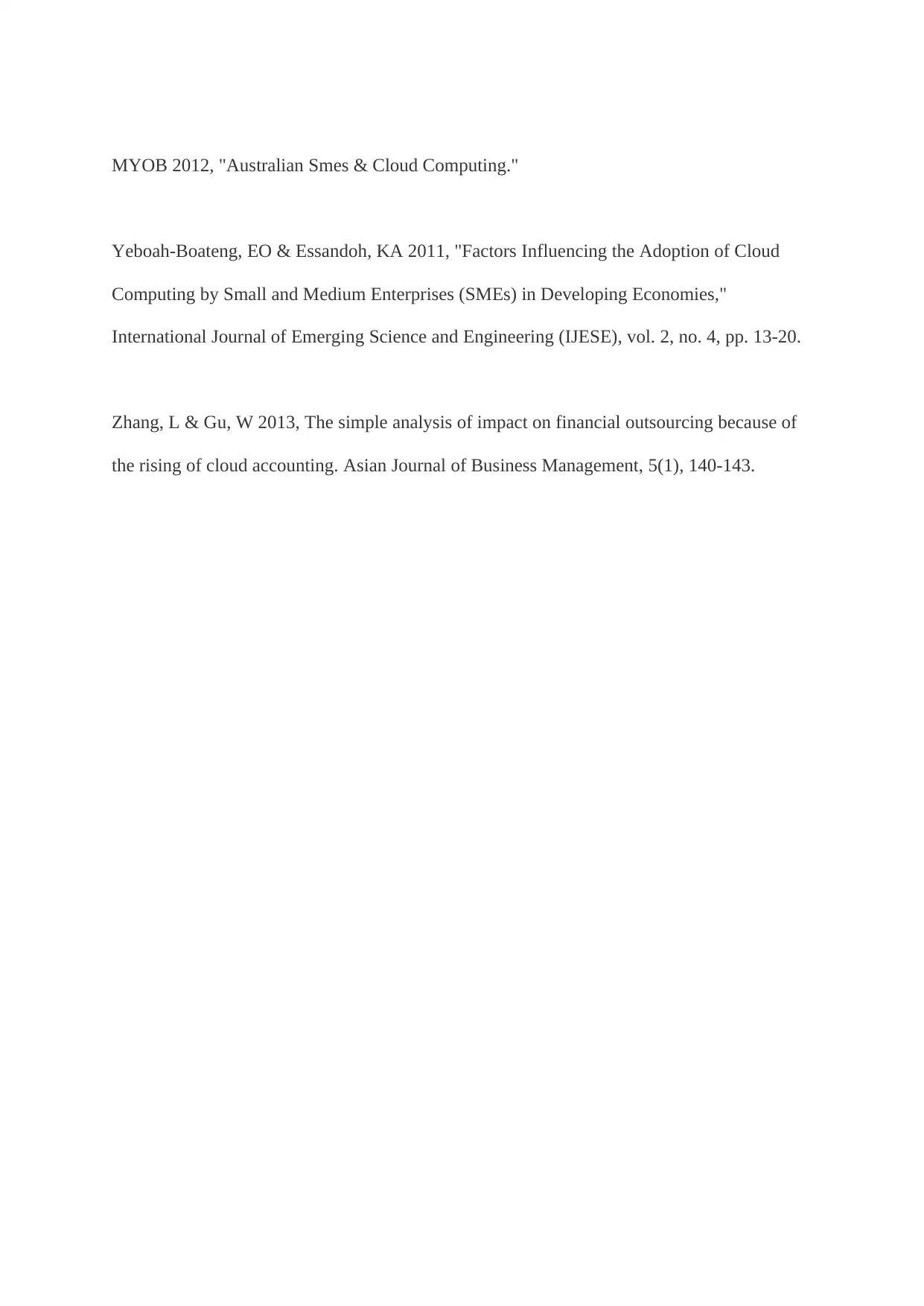
MYOB 2012, "Australian Smes & Cloud Computing."
Yeboah-Boateng, EO & Essandoh, KA 2011, "Factors Influencing the Adoption of Cloud
Computing by Small and Medium Enterprises (SMEs) in Developing Economies,"
International Journal of Emerging Science and Engineering (IJESE), vol. 2, no. 4, pp. 13-20.
Zhang, L & Gu, W 2013, The simple analysis of impact on financial outsourcing because of
the rising of cloud accounting. Asian Journal of Business Management, 5(1), 140-143.
Yeboah-Boateng, EO & Essandoh, KA 2011, "Factors Influencing the Adoption of Cloud
Computing by Small and Medium Enterprises (SMEs) in Developing Economies,"
International Journal of Emerging Science and Engineering (IJESE), vol. 2, no. 4, pp. 13-20.
Zhang, L & Gu, W 2013, The simple analysis of impact on financial outsourcing because of
the rising of cloud accounting. Asian Journal of Business Management, 5(1), 140-143.
You're viewing a preview
Unlock full access by subscribing today!
1 out of 12
Related Documents
Your All-in-One AI-Powered Toolkit for Academic Success.
+13062052269
info@desklib.com
Available 24*7 on WhatsApp / Email
![[object Object]](/_next/static/media/star-bottom.7253800d.svg)
Unlock your academic potential
© 2024 | Zucol Services PVT LTD | All rights reserved.





